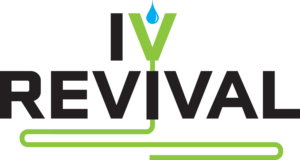May is National Blood Pressure Month. Since we at IV Revival are all about optimizing your health, we want to share some tips on how to maintain a healthy blood pressure level.
First off, blood pressure is simply the pressure in your blood — it’s how hard it is pressing against the walls of your blood vessels. It’s routinely checked by doctors because it can contribute to fatal health problems, such as heart attacks, strokes, and heart failure.
Medically speaking, the inflammation caused by high blood pressures leads to cholesterol and other substances to clump and form plaque on your artery walls. When plaque ruptures, clots form that can cut off blood flow to the heart (causing a heart attack) or brain (causing a stroke).
How is Blood Pressure Found?
If you’ve been to the doctor recently, you probably had them compress your arm with a band and pump air into that band. They then wait, listen to your pulse, and say two numbers: something over something. That’s your blood pressure!
Your total blood pressure reading is determined by measuring your systolic and diastolic blood pressures. Systolic blood pressure, the top number, measures the force your heart exerts on the walls of your arteries each time it beats. Diastolic blood pressure, the bottom number, measures the force your heart exerts on the walls of your arteries in between beats.
Blood pressure readings fall into four general categories, ranging from normal to stage 2 high blood pressure (hypertension). The level of your blood pressure determines what kind of treatment you may need. The Mayo Clinic has a very comprehensive and easy to read chart on it.
About 76 million adult Americans have high blood pressure, or hypertension. That means they have a top (systolic) number of 140 or higher or a bottom (diastolic) number of 90 or higher. Most of them don’t have their blood pressure under control.
Blood Pressure Categories
There are five blood pressure ranges that are recognized by the American Heart Association. They are:
Normal
Blood pressure numbers of less than 120/80 mm Hg are considered within the normal range.
Elevated
Elevated blood pressure is when readings consistently range from 120-129 systolic and less than 80 mm Hg diastolic (like 125/75). People with elevated blood pressure are likely to develop high blood pressure unless steps are taken to control the condition.
Hypertension Stage 1
Hypertension Stage 1 is when blood pressure consistently ranges from 130-139 systolic or 80-89 mm Hg diastolic. At this stage of high blood pressure, doctors are likely to prescribe lifestyle changes and may consider adding blood pressure medication to help lower your blood pressure.
Hypertension Stage 2
Hypertension Stage 2 is when blood pressure consistently ranges at 140/90 mm Hg or higher. At this stage of high blood pressure, doctors are likely to prescribe a combination of blood pressure medications and lifestyle changes.
Hypertensive Crisis
This stage of high blood pressure requires medical attention. If your blood pressure is higher than 180/120 mm Hg and you are experiencing chest pain, shortness of breath, back pain, numbness/weakness, change in vision or difficulty speaking, call 911 immediately.
How to Prevent High Blood Pressure/Maintain a Healthy BP
Unfortunately, there isn’t a shortcut for maintaining or preventing high blood pressure. The only way to consistently be within a healthy range is to eat a good diet and exercise regularly.
You can help control your blood pressure by
-
Maintaining a healthy weight
-
Eating lots of fruits, vegetables, and whole grains
-
Limiting saturated fat
-
Reducing sodium intake
-
Being physically active for at least 30 minutes every day
-
Quitting smoking.
Take care of yourself and your body will take care of you! We hope you found this blog informative, and we wish you a wonderful rest of the month.
